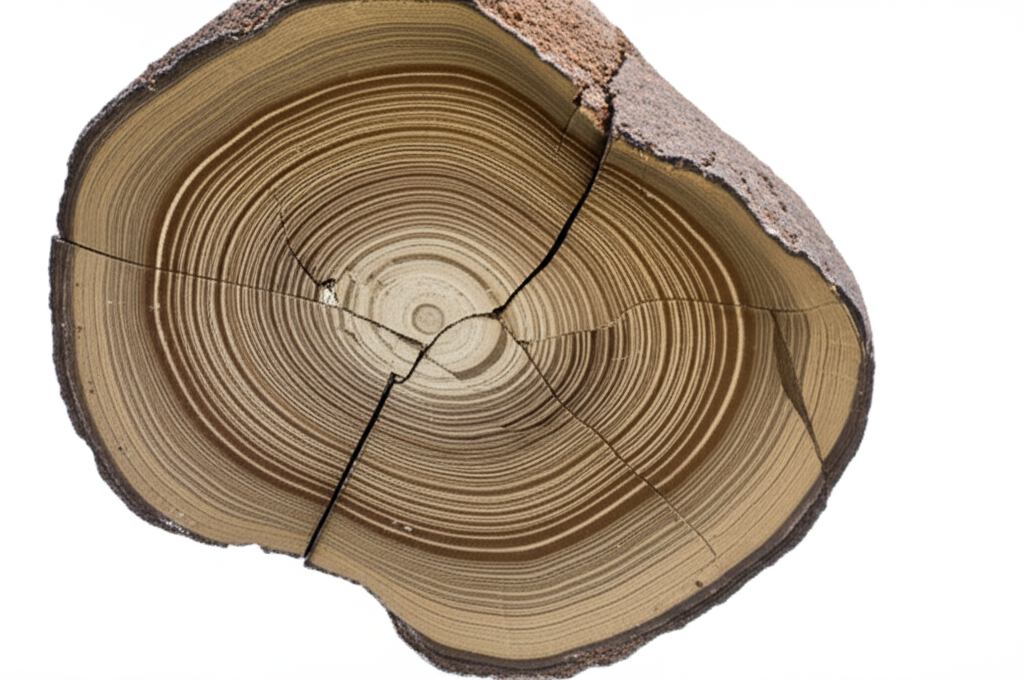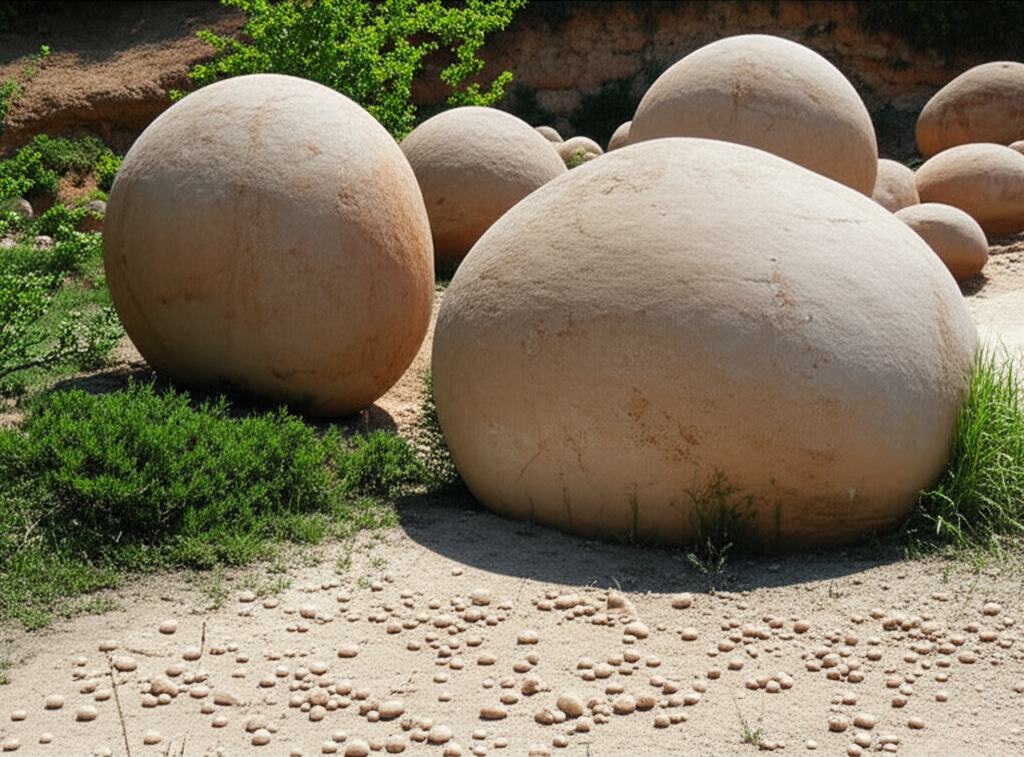Have you ever imagined stones that seem to grow or even subtly shift positions on their own? It sounds like something out of a fantasy tale, yet in certain corners of the world, nature presents phenomena that challenge our conventional understanding. One of the most captivating examples can be found in Romania: the enigmatic Trovants. These geological formations have earned the nickname “living stones” due to their peculiar characteristics. If you’re fascinated by natural wonders like the Giant’s Causeway in Northern Ireland, Romania’s Trovants offer a different, equally intriguing mystery waiting to be explored. Found primarily in Vâlcea County, these oddly shaped rocks stand out from their surroundings, sparking both scientific curiosity and local legends. This article will journey into the world of Trovants, uncovering their true geological story, separating fact from myth, and highlighting what makes them a truly unique natural treasure.
What Exactly Are Trovants?
At first glance, Trovants appear simply as oddly shaped rocks. They come in a variety of forms, from nearly perfect spheres and nodules to more irregular, sometimes distorted shapes. Their textures can vary, and their colors often reflect the local soil and minerals, typically browns, greys, or reddish hues.
Scientifically speaking, Trovants are classified as a specific type of geological concretion. They aren’t formed like typical igneous or metamorphic rocks but are created within existing sedimentary layers. You typically find them embedded within beds of sand, gravel, or conglomerate rock.
These concretions form over vast stretches of geological time. Their unique appearance and the folklore surrounding them make them a subject of particular interest to geologists and tourists alike. They are a testament to the slow, continuous processes shaping the Earth’s crust.

Where Do These “Living Stones” Reside?
Romania is the most famous location for Trovants, particularly within the region of Vâlcea County.
The most significant and well-known site is the Trovants Museum Natural Park (Muzeul Trovanților) in Costesti. This protected area showcases a remarkable collection of Trovants of various sizes and shapes, allowing visitors to walk among them and observe their diversity. The surrounding landscape is typically hilly, semi-forested terrain, where Trovants can be found both embedded in the earth and scattered on the surface due to erosion.
While similar concretionary formations exist in other parts of the world, the abundance, variety of shapes, and often large sizes of the Romanian Trovants, especially those found in protected areas, make them exceptionally prominent and studied compared to their global counterparts.
The Deep Dive: Geology and Formation
Understanding Trovants requires a look into the slow, patient world of geological processes. Their creation is a fascinating story of minerals, water, and time interacting within the Earth’s layers.
Beyond a Simple Stone: Concretion Explained
Geological concretions, in general, are hard, compact masses formed by the precipitation of mineral cement around a nucleus within sedimentary rock or soil. Think of it like mineral “glue” binding together sediment particles. This process typically happens when groundwater carrying dissolved minerals flows through porous sediment layers like sand or silt.
As conditions change – perhaps due to evaporation, microbial activity, or pressure changes – the dissolved minerals precipitate out of the water. They then begin to crystalize and cement the surrounding sediment particles together, often starting around a small object like a shell fragment or pebble.
The Unique Trovant Recipe
Trovants follow the general concretion process but with specific ingredients. Their structure usually involves a core, which can be a small stone, a fossil fragment, or even a piece of vegetation (though the latter is less common for the core). Surrounding this core is a mixture of sand and gravel, tightly bound together by a cementing agent.
The primary cementing mineral in many Trovants is calcium carbonate, the same mineral that makes up limestone and seashells. This mineral-rich solution, percolating through ancient sand and gravel beds (often related to past rivers or seas), slowly binds the loose sediment particles. The original sediment layer, perhaps a sandy conglomerate, dictates the material available for the concretion to form from.
The Slow Dance of “Growth”
The appearance of ‘growth’ in Trovants is perhaps their most intriguing feature. It’s not biological growth, but a process called accretion. When Trovants become wet, especially after rain, water seeps into the porous outer layers. This water often carries dissolved minerals.
As the water evaporates or conditions change, these new minerals precipitate and deposit on the outer surface of the concretion, adding a new layer. This layer-by-layer deposition of mineral cement around the existing structure causes the Trovant to expand or swell slightly over time. This expansion is incredibly slow – perhaps only a few millimeters over many decades or even centuries – but it creates the illusion of the stone growing.
Do Trovants Really Move? Unpacking the Myths
Local folklore and some sensationalized reports suggest that Trovants can move on their own, adding to their “living” reputation. While they certainly don’t walk or roll uphill autonomously, there are scientific explanations for why they might appear to shift over time.
Here’s what’s actually happening:
- Erosion: As the softer soil and sediment surrounding a buried Trovant gradually erode away from rain and wind, the Trovant, being harder, becomes more exposed. This differential erosion can make it look as though the stone has ‘risen’ out of the ground.
- Gravity and Slope: On gentle slopes, the slow downhill movement of surface soil and sediment due to gravity (known as soil creep) can cause embedded stones to slowly migrate downslope over very long periods.
- Frost Heave and Ground Movement: In areas experiencing freezing temperatures, the expansion and contraction of water in the soil (frost heave) can subtly push objects upwards or sideways. Other minor geological shifts or ground disturbances can also contribute to slight displacements.
These processes are slow and passive. Trovants lack any form of biological propulsion or internal mechanism for self-movement. The perceived movement is a result of external environmental forces acting on them and the surrounding landscape over geological timescales.
Why Trovants Are Special: Uniqueness Factors
While concretions exist globally, Romanian Trovants stand out due to several factors that combine to make them particularly remarkable and the source of their “living stone” mystique.
Key features that make Trovants special include:
- Dramatic Size Range: Trovants found in Romania exhibit an incredible range of sizes, from tiny pebbles just a few millimeters across to massive boulders weighing several tons. This vast scale is not as commonly observed in many other concretion sites.
- Visible Accretion Rings: When Trovants are broken open (though this is discouraged, especially in protected areas), they often reveal distinct, concentric rings around a core. These rings visually record the layer-by-layer mineral deposition process, a feature particularly pronounced and clear in many Trovants.
- Apparent “Growth”: The visible swelling or expansion due to mineral deposition when wet is a highly noticeable characteristic that directly contributes to their “living” nickname and sets them apart from static rocks.
- Abundance and Variety: The sheer number and diverse array of shapes and sizes found concentrated in specific areas, like the Trovants Museum Park, create a striking visual spectacle that is less common for other types of concretions.
This combination of notable apparent growth, wide size variation, clear internal structure, and concentrated occurrence makes the Romanian Trovants uniquely fascinating geological subjects.

Visiting the Trovants: Experiencing the Natural Wonder
For those eager to see these geological oddities firsthand, a visit to Romania is essential. The most accessible and impressive site is the Trovants Museum Natural Park in Costesti, Vâlcea County.
The park is set up to allow visitors to walk freely among many Trovants of different sizes, spread out across a natural landscape. There are paths to follow, and the larger stones are particularly striking. Facilities might be basic, emphasizing the natural environment.
Here are a few tips for visiting:
- Footwear: Wear sturdy, comfortable shoes suitable for walking on uneven terrain.
- Best Time: Spring or autumn often offer pleasant weather, though they are accessible year-round. Visiting after rain might make the ‘swelling’ aspect slightly more active, but be prepared for mud.
- Respect the Site: Do not attempt to move, damage, or remove Trovants. They are protected geological formations.
- Guides: Local guides might be available to provide more in-depth information about the geology and local legends.
Experiencing the Trovants is about appreciating the slow, powerful forces of nature and witnessing geology in action, albeit on a timescale far grander than our own.
Legends and Local Lore
Before scientific explanations offered clarity, the mysterious nature of Trovants naturally gave rise to local myths and legends in the communities living near where they are found. Their strange shapes, apparent growth, and occasional shifts likely fueled imaginative tales.
Folklore often sought to explain the inexplicable. Were these stones the petrified eggs of ancient giants? Did they hold spirits or possess magical properties? Some stories might have linked their presence to specific historical events or mythical beings associated with the land. These local interpretations highlight how humanity has long tried to understand and assign meaning to unusual natural phenomena, weaving them into the cultural fabric of the region.
Protecting These Natural Wonders
Given their scientific value and unique appeal, the conservation of Trovant sites is crucial. The establishment of protected areas like the Trovants Museum Natural Park in Costesti is a vital step in safeguarding these formations.
Disturbing Trovants, whether by removing them, carving into their surfaces, or altering their surroundings, can damage these delicate geological records. Such actions hinder scientific study and diminish the natural beauty and integrity of the sites for future generations. Responsible tourism means sticking to designated paths, not touching or climbing on the stones (especially fragile ones), and leaving the environment exactly as you found it. Protecting these sites ensures that the mystery and scientific lessons held within the Trovants remain accessible for years to come.
Conclusion
From baffling “living stones” of folklore to fascinating geological concretions, the journey to understanding Romania’s Trovants is a compelling one. While they do not possess biological life or independent movement, their unique formation process, apparent growth through accretion, and striking variety in size and shape make them truly exceptional.
Trovants stand as a significant natural wonder, a testament to the slow, persistent forces that shape our planet over millions of years. They remind us that even seemingly inert objects can be part of dynamic, ongoing geological stories. The scientific interest in Trovants continues, offering insights into sedimentary processes and mineral deposition. Ultimately, the enduring allure of Trovants lies in their ability to spark our curiosity, blurring the lines between myth and the astonishing reality of Earth’s natural mysteries.
FAQ
Q: Do Trovants actually “grow” like plants?
A: No, Trovants do not grow biologically. Their apparent growth is a geological process called accretion, where dissolved minerals in water are deposited layer by layer on their outer surface, causing them to expand very slowly over time.
Q: Can Trovants move on their own?
A: No, Trovants do not have biological mobility. Any perceived movement is due to external environmental factors like erosion of surrounding soil, gravity on slopes, or ground movements like frost heave occurring over long periods.
Q: Where is the best place to see Trovants?
A: The most famous and accessible location is the Trovants Museum Natural Park in Costesti, Vâlcea County, Romania, which hosts a large collection of these formations.
Q: What are Trovants made of?
A: Trovants are composed of a core (like a pebble or fossil) surrounded by sand and gravel cemented together by mineral deposits, most commonly calcium carbonate.
Q: Why are Trovants important?
A: Trovants are important geological formations that provide insight into sedimentary processes, mineral precipitation, and the long timescale of Earth’s history. They are also a unique natural attraction and part of local cultural heritage.

